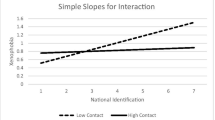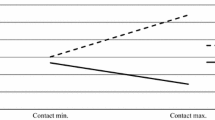Abstract
In this article we present a qualitative analysis of empirical findings from an international project on intergroup attitudes and contact in five Central European countries specifically concerning language use. The project concentrated on the interplay of intergroup contact and perception between the members of national groups in the borderlands between the Czech Republic and Austria, Germany, Poland and Slovakia. The open statements analysed here about the contact situations and the ensuing evaluation of the Others were collected as part of an online questionnaire (N=1959). After a short theoretical introduction we reveal the intertwined nature of construing language use: first in each specific borderland, then in the triads speaking together either in the native language of one of the groups (Czechs with Austrians and Germans) or with each speaking their own native languages (Czechs with Poles and Slovaks). Finally we highlight several effects we have observed as a result of being able to compare the situation in more than one neighbourhood, for instance, the effect of the different statuses of the languages involved, or the connection between the language used in contact and a feeling of proximity.
Similar content being viewed by others
References
Appel, R., Muysken, P. (2006). Language Contact and Bilingualism. Amsterdam: Amsterdam University Press.
Buchtík, M. (2012). Sympatie české veřejnosti k některým zemím — říjen 2012. [The Affinity of the Czech Public towards Other Countries — October 2012]. Praha: Sociologický ústav Akademie Věd České republiky, v.v.i. Retrieved March, 29, 2013 from http://cvvm.soc.cas.cz/mezinarodni-vztahy/sympatie-ceske-verejnosti-k-nekterym-zemim-rijen-2012
Carli, A., Guardiano, C., Kaučič-Baša, M., Sussi, E., Tessarolo, M., Ussai, M. (2003). Asserting Ethnic Identity and Power through Language. Journal of Ethnic and Migration Studies 29(5), 853–883.
Clemént, R. (1986). Second Language Proficiency and Acculturation: An Investigation of the Effects of Language Status and Individual Characteristics. Journal of Language and Social Psychology 5(4), 271–290.
Dolińska, K. (2013). Teoretyczne i praktyczne aspekty badania sąsiedztwa na pograniczu [Theoretical and Practical Aspects of the Research into Neighbourhood in the Borderlands]. In M. Dębicki, J. Makaro (Eds.). Sąsiedztwa III RP — Czechy. Zagadnienia społeczne, pp. 241–258. Wrocław: Gajt.
Geertz, C. (1973). The Interpretation of Cultures. Selected Essays by Clifford Greetz. New York: Basic Books.
Holly, W., Nekvapil, J., Scherm, I., Tišerová, P. (2003). Unequal Neighbours: Coping with Asymmetries. Journal of Ethnic and Migration Studies 29(5), 819–834.
Hřebíčková, M., Kouřilová, S. (2012). Jak se vidíme, jak nás vidí a jací jsme: Porovnání národního auto- a heterostereotypu s posuzováním reálných lidí v kontextu pětifaktorového modelu osobnosti. [How we See Ourselves, How We Are Seen and How We Are: Comparison of National Auto- and Hetero-Stereotypes with Judgements by Real People in the Five-Factor Personality Model.] Československá psychologie 56, 1–17.
Kłoskowska, A. (2005). Kultury narodowe u korzeni [The Roots of Ethnic Cultures]. Warszawa: PWN.
Kanovský, M. (2009). Reprezentácie „etnicity“ na západnej Ukrajine a na východnom Slovensku [Representations of “Ethnicity” in Western Ukraine and Eastern Slovakia]. In P. Dráľ, A. Findor (Eds.). Ako skúať národ. Deväť štúdií o etnicite a nacionalizme [Exploring the Nation. Nine Studies on Ethnicity and Nationalism], pp. 9–34. Brno: Tribun.
Kouřilová, S., Hřebíčková, M. (2011). Accuracy of Slovak National Stereotypes: Result of Judgment or Intuition? Studia Psychologica 53, 201–213.
Kouřilová, S. (2011). Perception of Intergroup Contact in Border Regions: A Czech-Austrian Case Study. In M. S. Roberto, M. T. Batista, M. H. Santos, R. Morais, R. S. Costa, M. L. Lima (Eds.). Research Directions in Social and Organizational Psychology (Vol. IV). Lisbon: Edições Colibri.
Láš⇔cová, B. (2006). Identification with Large Scale Social Categories: A Social Psychology Perspective. Sociológia — Slovak Sociological Review 38(6), 546–561.
Láš⇔cová, B. (2009). Slováci a/alebo Európania?: kolektívne identity, sociálne reprezentácie a spoločenská zmena [Slovaks and/or Europeans?: Collective Identities, Social Representations and Social Change]. In Ako skúmať národ: Deväť štúdií o etnicite a nacionalizme. [Exploring the Nation. Nine Studies on Ethnicity and Nationalism], pp. 35–36. Brno: Tribun EU.
Leix, A. (2011). Vztah Poláků k Čechům — vývoj a souvislosti [The Historical Background and Current Relations of the Polish towards the Czechs]. In K. Bartošová, M. Čerňák, P. Humpolíček, M. Kukaňová, A. Slezáčková (Eds.). Sociální procesy a osobnost 2011: Člověk na cestě životem: křižovatky a mosty, pp. 171–175. Brno: Tribun EU.
Leix, A. (2012): My jim rozumíme, oni nám ne: specifika česko-polské komunikace očima Čechů a Poláků [We Do Understand Them, But They Do Not Understand Us: The Specifics of the Czech-Polish Communication by Czechs and Poles]. In R. Masaryk, M. Petrjanošová, B. Lašticová (Eds.). Diverzita v spoločenských vedách, pp. 185–192. Bratislava: Ústav výskumu sociálnej komunikácie: SAV.
Leix, A. (2013). „Pepiki” i „Pšonci”: co u siebie wzajemnie lubią, co ich zaskakuje, czego nie lubią, a co wywołuje ich uśmiech? [„Pepici” and „Pšonci”: what they like about each other, what surprises them, what they do not like about each other and what makes them laugh]. In M. Dębicki, J. Makaro (Eds.). Sąsiedztwa III RP — Czechy. Zagadnienia społeczne, pp. 117–141. Wrocław: Gajt.
Leix, A. (2013). I was expecting her to be fanatic Catholic, but she was not. How International Exchange Programmes Reduce Prejudices. The New Educational Review 31(1), 205–216.
Leix, A., Petrjánošová, M. (2012). Spoluobčané, pokrevní bratři a “Čechoslováci”-reflexe “příuzenství” ve výpovědích Čechů, Poláků a Sloválů. [Fellow Citizens, Brothers in Blood and “Czechoslovaks“” — Reflection of “Kinship” in Czech, Polish and Slovak Statements]. In P. Halama, R. Hanák, R. Masaryk (Eds.). Sociálne procesy a osobnos? 2012: Zborník príspevkov z 15. ročnía medzinárodnej konferencie, pp. 31–35. Bratislava: ústav experimentálnej psychológie SAV.
Nábělková, M. (2008). Slovenčina a čeština v kontakte. Pokračovanie príbehu. [Slovak and Czech in Contact: A Continuation of the Story]. Bratislava: VEDA, vydavate?stvo SAV.
Petrjánošová, M. (2010). Ako súvisia sebavedomie, jazykové spôsobilosti a ekonomické rozdiely: obraz suseda vo voľných výpovediach Nemcov o Čechoch a Čechov o Nemcoch [When Self-Importance, Language Skills and Economic Differences Come Together: Images of the Neighbour in Open Statements of Germans about Czechs and Czechs about Germans]. In K. Bartošová, M. Čerňák, P. Humpolíček, M. Kukaňová, A. Slezáčková (Eds.). Sociální procesy a osobnost 2011: člověk na cestě Životem: křiŽovatky a mosty. Sborník příspěvků, pp. 233–237. Brno: Tribun EU.
Petrjánošová, M. (2011). Starší a mladší brat? Obraz suseda vo voľných výpovediach Slovákov o Čechoch a Čechov o Slovákoch [The Older and the Younger Brother? Images of the Neighbour in Open Statements-Slovaks about Czechs and Czechs about Slovaks]. In D. Fedáková, M. Kentoš (Eds.). Sociálne procesy a osobnosť 2010. Zborník príspevkov, pp. 278–283. Košice: Spoločenskovedný ústav SAV.
Petrjánošová, M. (2012). “I can’t speak German so I can’t communicate with them”: Language Use in Intergroup Contact between Czechs and Germans. Human Affairs 22, 69–78.
Petrjánošová, M., Graf, S. (2012). “The Austrians were surprised that I didn’t speak German”: the Role of Language in Czech-Austrian Relations. Human Affairs 22, 539–557.
Roguska, B. (2013). Stosunek Polaków do innych narodowości [Attitude of Poles to other nationalities]. Warszawa: Centrum Badania Opinii Publicznej. Retrieved March, 29, 2013 from http://www.cbos.pl/SPISKOM.POL/2013/K_012_13.PDF
Whorf, B. L. (1956). Language, Thought and Reality. Edited and with introduction by John B. Carroll. Cambridge, MA: MIT.
Author information
Authors and Affiliations
Corresponding author
Additional information
The article was supported by grant no. 13-25656S from the Czech Science Foundation and by RVO: 68081740 from the Institute of Psychology, Academy of Sciences of the Czech Republic. We would like to thank all anonymous reviewers as well as non-anonymous colleagues for their comments and suggestions, especially Barbara Lášticová.
About this article
Cite this article
Petrjánošová, M., Leix, A. Languages of borderlands, borders of languages: Native and foreign language use in intergroup contact between Czechs and their neighbours. Humaff 23, 658–679 (2013). https://doi.org/10.2478/s13374-013-0156-y
Published:
Issue Date:
DOI: https://doi.org/10.2478/s13374-013-0156-y




